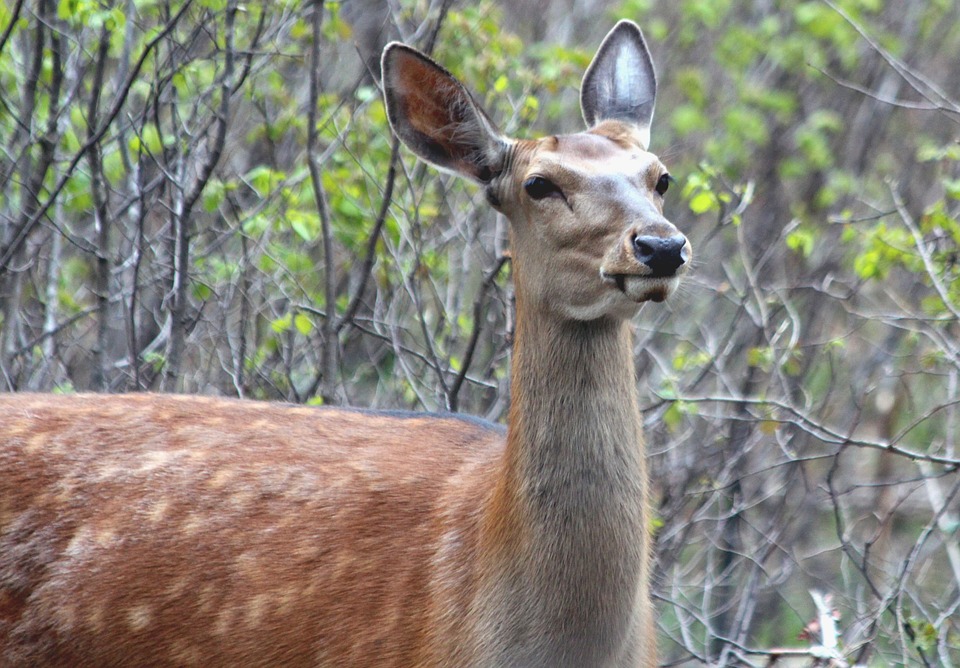Humans seem to be creatures of high comfort in all situations, right? We choose nice and cozy houses to keep us warm in the cold winter, cool in the hot summer, and dry when it’s rainy. In our house, everything is selected and arranged in the most convenient way. Nice, pillowy mattresses or sleeping bags. Full of favorite foods. Even when going out or taking part in any outdoor activities, we will bring everything that keeps ourselves in the highest levels of comfort.
Meanwhile, whitetail deer don’t have luxuries like that. They have to live outdoors, even under the most severe weathers. Especially whitetail deer’s food sources are things available in their area at any time of year. Their own metabolisms and fur coats enable them to withstand cold temperatures that would freeze most humans to death. It’s truth that deer are more highly adaptable than humans.
Because of living outdoors 24 hours per day, 7 days per week, the whitetail deer have full experience in all situations, even seem to have some innate sixth sense to predict any weather matters. Thus, while humans tend to avoid hunting in bad weather, they still act in their own world by their own way. Whitetail deer hunting in harsh conditions may bring to you an exciting experience. Of course, remember that adverse weather means that your hunting tactics should be adapted to. Let’s take a look at how to hunt whitetail deer during severe weather conditions.

Whitetail deer hunting when it’s rainy
In fact, a little bit of rain will not slow whitetail deer down or change their behavior patterns. But it doesn’t mean that they will never alter their behavior because of rain. During the heavily rainy conditions, it’s difficult for deer to smell, observe and hear anything. So they avoid moving this time until the rain quits.
Deer have an incredible, innate, ability to sense approaching storms, so they tend to fill their belly before and after storms. Deer are fully aware that storms may force them into their beds for an undetermined period of time.
For light rain or drizzle, you don’t have to change in tactics, as the little rain can’t affect much animal movements. Daily activities might be delayed slightly, it often appears on cloudy days, even until late morning or early evening.
In the moderate rain, some improvisation may appear, but try still-hunting. The best places for this condition are pastures, especially with multiflora rose or blackberry thickets, or cornfields, pine stands. If possible, spot-and-stalk can be effective. Remember that it’s the eyes, not the legs that mark your success.
Meanwhile, if it heavily rains, the best advice for you is wait this out. In this condition, every living thing tends to seek some sort of shelter. However, the period after the heavy rain will be a good time for hunting, because animals continue normal activities.
Whitetail deer hunting when it’s windy
Every human action depends on the wind. A bit of wind can’t make us scared away from the playground, but gale force winds will keep us indoors. In heavy winds like that, we never know what dangers we may face from flying things.
The behavior of deer isn’t much different from our own in this instance. They will not change their behavior significantly because of a little bit of wind. The best movement and activity are in 5- to 15-mph conditions. Movements dramatically declined when wind speeds reached 15 to 19 mph, but then shot back up when wind speeds exceeded 20 mph. Thus, you can also use these winds to your advantage as well.
First of all, high winds mean that everything is moving. But it can be used to your advantage when you’re in a treestand. You just need to sit tight and let the wind blow everything around. Then the deer will go back to feeding. If you have a ground blind, put it up, as it can make your hunt more comfortable. Remember that the wind should be strong to bring many extra stakes for your blind.
Next, it’s extremely helpful when the high winds may cover up all sound you make. You can easily find one bedded and come up with a good plan to keep the prey from seeing you and scenting you. The chances of success seem to be pretty high. To check the wind speed, keep a wind puffer on yours.
Many people think that high winds will destroy calling in whitetail deer, but in fact, you can still be successful if you do it right. You should find something to prevent the deer from getting directly the wind. It will be nice if you set up next to a pond, a river or steep ravine. However, in the windy conditions, you have to wait for about twice as long as normal. The sound of rattling or a grunt tube can travel a long way.
Lastly, making a shot in high winds will be effective when you understand wind drift. So don’t worry if you have to face with hunting in high winds. The game will be often spooky in high winds and many people think that a good hunt only comes when the winds pick up.

Whitetail deer hunting when it’s snowy
Similar to heavy rain and other harsh weather conditions, whitetail deer hunting will alter significantly. As deer act less in heavy snowfall, especially blizzards. They tend to feed 6 to 18 hours before heavy snows set in, to consume and store as much food as possible. During the snowy storm, deer are forced to stay in their beds for a long time, they are often ravenously hungry when the weather finally passes. As a result, they also tend to feed heavily after the passing of the snowy condition. These are excellent times to go deer hunting as the deer will not only be feeding actively, but they will also be single-mindedly focused on their task making them less wary than usual.
However, not all of whitetail deer spend all their time on bedding when it’s snowy. With heavy snow, deer are more prone to visiting crops such as corn and beans. Theses food sources are above the snow and are easy pickings. Food plots and food sources (late season standing beans or corn) can be the big stage for hunts which have some of the highest likelihood of seeing mature bucks during daylight and getting a chance to harvest them.
Wrapping Up
Many whitetail deer hunters find extreme conditions inconvenient and uncomfortable, but the fact is that there are many hunting opportunities on days prior to and before harsh weather period. Instead of disparaging bad weather, hunters should embrace it to get the biggest bucks on their feet. Whether you’re facing extreme rain, wind, or snow, turn it into your advantage now!















